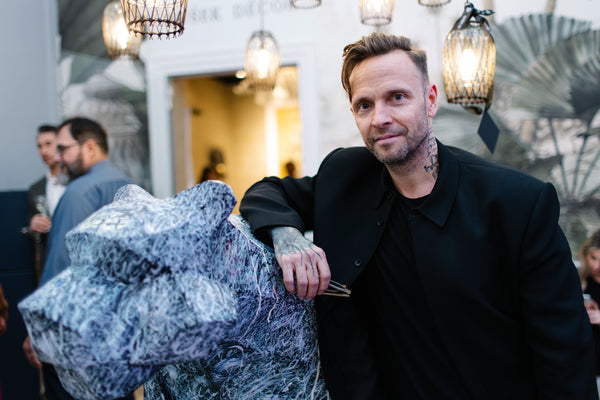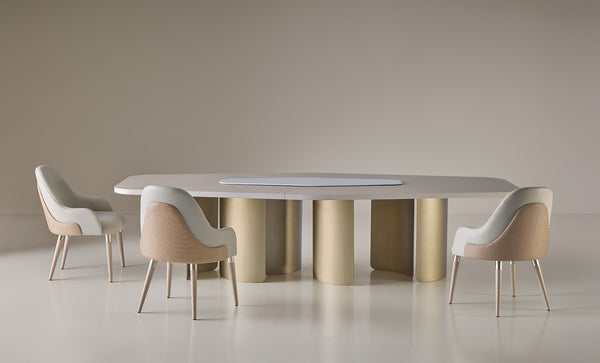Maxim
*Maxim Havlíček (1974)
Maxim Havlíček is a visual artist whose artistic language is rooted in calligraphy and abstraction. He was shaped both by Prague, marked at the time by the communist regime, and by the diversity and opportunities offered in Los Angeles. At an early age, he was also strongly influenced by his uncle, Ivan Sedliský, an academic painter trained in the classical tradition of fine arts. He studied at the School of Graphic Arts in Hellichova Street under Jan Sehnal, where he gained a comprehensive insight into the techniques of calligraphy, photography, and printing. In addition to visual art, he and his brother also pursued music from a young age.
Together with Maxim, we spoke about his path to art, his inspirations, and also about the future influence of AI on the art scene.
Can you tell us, and our readers, what your journey to painting looked like? And what do you enjoy most about this medium?
I studied graphic design at Hellichovka in Prague. Afterwards, I felt the need to take a break from school, so I went to Berlin, where I squatted around Tacheles and became part of the lively anarchist art scene (around 1995). After some time, I returned to Prague for a while. I packed my things and left for America. At that time, I went there to see a friend I used to play in a band with. Since childhood, I had always felt the pull to go abroad. Overall, my artistic journey really began with music at the age of 15. My brother and I had a band (he stayed with music), and I played guitar back then. In America, I also learned to play the drums and for a while even made a living from music. Later, I gradually found my way back to painting. I started painting full time around 2009/2010, when I moved within the US from the East Coast to Los Angeles and set up my first studio there.
Do you remember a key moment when you realized you would dedicate yourself to art?
It wasn’t one single breakthrough moment, but rather a period of several years. I went to America with just a backpack and about 200 CZK (Maxim laughs). I had to build everything from scratch, and that takes time. Back then, I had to focus first on making a living—especially when you arrive somewhere where nobody knows you. At first, I set up a very successful graphic design studio there. At the same time, I was creating and working in the studio. It was a tough period, I had no time for anything, but if you want something, you have to sacrifice for it. The company went on for another 20 years. Later, I left it and sold my share. My first solo exhibition convinced me that I could fully devote myself to painting. But it didn’t happen overnight. It was several years before it really broke through.
You mentioned having a background in graphic design. Does it reflect in your artistic work? I would describe your work as clean and linear—has it always been like that?
The lines you mentioned are essentially calligraphy—text—and that is a pure form, even if it might look like chaos. That chaos arises because it’s layered calligraphy. At the same time, I also use different techniques that create texture in the works, which gives the paintings depth. Earlier, I also did semi-figurative and figurative work, but the figure limited me to a certain extent. I didn’t want to paint what I saw; I wanted to describe it. I got the foundations of calligraphy mainly during my studies at Hellichovka. Professor Sehnal, who later became the school’s director, somehow instilled it in me. Everyone struggled with it, but to me, it actually seemed quite simple.
Writing carries both form and content. Words and sentences are born from it. On top of that, we have countless types of scripts (Arabic, Egyptian, Hebrew, Cyrillic, Latin). A single word can be written in different languages/scripts and it always looks different, but the meaning stays the same. And that fascinated me.
Can we see specific texts in your paintings, or in the Panther you created for Dušek Décor?
Yes, every painting contains an encrypted message, and it’s up to each viewer to decipher it—it doesn’t have to be taken literally. Many times, people come to me saying they see shapes or figures in my paintings. I don’t put them there intentionally, but I can’t tell them they’re wrong—maybe it was some symbol at that moment.
My work is essentially gestural and linear. It is more or less abstraction—a depiction of something that cannot be described figuratively. Each person creates their own reality with their consciousness, and this is the reality I see. All the writing in the paintings are thoughts passing through my head. At first, I tried to keep the writing legible, but that limited my freer gestures—my head worked faster than my hand. So I started creating my own “shorthand.” Sometimes symbols appear as well, replacing certain passages of thought. They are like archival records of the moment when the work was created.
Is there an artist you identify with or draw inspiration from? In your work I sense, for example, the influence of Cy Twombly.
Yes, Cy Twombly and also Antoni Tàpies. I’ve traveled the world and had the chance to see their works. Antoni Tàpies was a Catalan painter. In Barcelona, there’s an entire museum dedicated to him, which I visited. And, of course, Cy Twombly. Just about a month ago, I was in Munich, where there was an amazing exhibition at the Museum Brandhorst called Five Friends.
Right now, I am drawn to learn as much as I can about the people behind the art and what drove them to create. Twombly has fascinated me for a very long time, and I’ve always wondered why he used writing. Tàpies influenced me in an earlier phase. I worked with materials. It leaned toward art informel—I often used marble (crushed marble). I shaped it on canvas, and only after it dried did I apply paint on it. I found that approach in Tàpies’ work. His symbolism also resonated with me. Symbols have a great expressive power. They don’t need translation—crosses, circles are universally understood. It’s a different kind of language. I’m also fascinated by mathematics. Numbers, in a way, also work as a universal language on their own.
Where do you draw inspiration for your paintings?
I read a lot, mainly scientific literature. I’m interested in it especially when combined with philosophy. Science is something objective. Physical laws apply to everyone. I’m fascinated, for example, by the possibilities of parallel universes. Three years ago, I created an entire series of paintings Parallel Universes (2021–2022), where I explored how each small decision shapes our path. How these possibilities open our journey exponentially in all directions. Time ceases to be linear; everything happens at once, and we only accept one option. In general, I believe that there is no such thing as coincidence. But we must be aware of the uniqueness of each moment and the fact that nothing lasts forever.
Art must also constantly evolve. I don’t want to rest on my laurels. I don’t believe in finding some universal recipe and doing it for the next 30 years. Then it would just become a job—and what I value most is that I “don’t have a job.”
I wonder, do you fear that with the rise of AI, art will decline and people will stop buying paintings?
AI will certainly bring unprecedented changes, but art and things created by human consciousness and hands cannot be taken from us. I’m convinced that, on the contrary, art, music, and the entire human experience recorded in some form will only rise. AI may do design, architecture, maybe even teaching for us. But it should be used only as a tool. I myself am learning how to communicate with AI. It can be a great benefit and a way to ease the workload, but there must always be human supervision. People need to be proactive and know how to work with it. A robot simply doesn’t have that energy and cannot replace art, theater, or dance.
What are your plans for the future? Are you preparing an exhibition where readers could see your work (apart from Dušek Décor)?
I have a major solo exhibition coming up in Sydney, Australia, this November. In the Czech Republic, we’re also preparing a group exhibition Natural Selection with the Artefin gallery this autumn (September 26, 2025).
Since your works will now also be on view in the Dušek Décor showroom, can you tell us how this collaboration came about?
It was actually very simple. We connected on Instagram and for a while just followed each other. Then one day, I was at a café on Palmovka with my daughter, and I noticed that right across the street was Dušek Décor, which I already knew from Instagram. We went inside, and that’s how it all started.
Finally, what would you say to young or emerging artists who feel the need to create but are afraid there might not be a place for them in the art world?
The main thing is not to be afraid. There’s a lot of societal pressure that you have to earn money to survive. That’s why in the beginning, you need to be a little modest—the money definitely won’t come right away. But the most important thing is to dedicate yourself 100% and persist. If money is more important to you, then art can only be a hobby. But if you want the audience to take you seriously, then you have to take it seriously yourself.
You can also see Maxim Havlíček’s works at the Dušek Décor showroom starting September 18, 2025.
Text: Barbara Kurzoková


